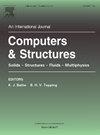A non-classical computational method for modelling functionally graded porous planar media using micropolar theory
IF 4.4
2区 工程技术
Q1 COMPUTER SCIENCE, INTERDISCIPLINARY APPLICATIONS
引用次数: 0
Abstract
The current study proposes a computational-based method to employ the non-classical micropolar continuum for modelling plates with in-plane functionally graded porosities. Initially, a homogenisation method is developed to derive the micropolar parameters of porous heterogenous plates based on strain energy equivalence in various designed deformations simulated via finite element analysis. The modelling procedure is further augmented to accommodate structures with functionally graded porosities. The established method offers an effective framework for studying the mechanical behaviour of porous plates with various porosity distributions and a wide range of aspect ratios. Results indicate that the micropolar theory-based modelling surpasses traditional Cauchy theory in accurately predicting the stiffness and displacement distribution of the FG porous structures. The novelty of this study lies in the integration of micropolar theory with the homogenisation of graded porosity patterns, offering enhanced predictions for materials with microstructural features. Additionally, a custom finite element formulation is developed in COMSOL to implement micropolar elasticity, significantly improving the computational efficiency to account for complex geometry, loading, and boundary conditions. To show the applicability of the method, the modelling is used to design a dental implant with its functional property mimicking that of the natural bone to avoid stress-shielding while ensuring proper occlusivity.
利用微极理论模拟功能分级多孔平面介质的非经典计算方法
目前的研究提出了一种基于计算的方法,利用非经典微观连续体为具有平面功能分级孔隙率的板材建模。首先,开发了一种均质化方法,通过有限元分析模拟各种设计变形,在应变能等效的基础上推导出多孔异质板的微观参数。对建模程序进行了进一步扩展,以适应具有功能分级孔隙率的结构。所建立的方法为研究具有各种孔隙率分布和各种长宽比的多孔板的力学行为提供了一个有效的框架。结果表明,在准确预测 FG 多孔结构的刚度和位移分布方面,基于微极性理论的建模超越了传统的柯西理论。这项研究的新颖之处在于将微波理论与分级多孔结构的均质化相结合,从而增强了对具有微结构特征的材料的预测。此外,还在 COMSOL 中开发了自定义有限元公式来实现微波弹性,从而显著提高了计算效率,以考虑复杂的几何形状、载荷和边界条件。为了展示该方法的适用性,我们使用该建模方法设计了一种牙科植入物,其功能特性模仿了天然骨骼的功能特性,以避免应力屏蔽,同时确保适当的咬合性。
本文章由计算机程序翻译,如有差异,请以英文原文为准。
求助全文
约1分钟内获得全文
求助全文
来源期刊

Computers & Structures
工程技术-工程:土木
CiteScore
8.80
自引率
6.40%
发文量
122
审稿时长
33 days
期刊介绍:
Computers & Structures publishes advances in the development and use of computational methods for the solution of problems in engineering and the sciences. The range of appropriate contributions is wide, and includes papers on establishing appropriate mathematical models and their numerical solution in all areas of mechanics. The journal also includes articles that present a substantial review of a field in the topics of the journal.
 求助内容:
求助内容: 应助结果提醒方式:
应助结果提醒方式:


